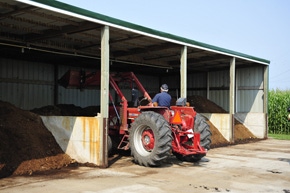December 14, 2011

Following an initial project begun in 1999 at the Iowa State University (ISU) swine breeding farm, the university’s swine teaching farm started composting mortalities eight years ago in an effort to increase biosecurity practices. Swine farms manager Jay Lampe says the move was positive.
“This process has changed our management style and lowered our biosecurity risks at the farm while providing a sustainable way of managing mortalities,” he says. “Composting has eliminated two potential sources of disease outbreaks for our farms: rendering and fuel trucks are no longer entering our property.”
“We are able to decrease the number of outside vehicles like rendering trucks entering the farm grounds, and that helps us keep our biosecurity at a high level,” Lampe says.
The size and cost to construct a composting facility varies according to available land, type of materials and size of mortalities to be composted. The swine teaching farm facility is completely roofed with eight bays, each of which is approximately 10 sq. ft. with four-ft.-high concrete walls. This allows adequate space for all carcass sizes from the farm to be incorporated.
ISU agricultural and biosystems engineering professor Tom Glanville says the correct process of preparing and using a mortality composting facility is vital to its success.
“Start by placing a 12-in. layer of dry cover material, like sawdust, wood shavings, or chopped corn stalk in the bottom of a compost bin,” he says. “Decaying carcasses will release excess moisture, so this absorptive base layer plays an important role in preventing release of excess liquid.”
Alternate layers of cover material with additional carcasses until the bin or bay is filled, Glanville says.
“The top layer should always be cover material,” he says. “Realize that you might not be able to fill an entire bin in a short period of time depending on your operation’s mortality rates and size of the moralities.”
After a bin is filled, the compost must undergo a primary heating cycle of 60 to 90 days. This time frame varies based on the size of mortalities placed in the bin. After this initial heating cycle, the partially composted carcasses are moved from the primary bin to a secondary bin.
“Moving the compost breaks up the materials in the pile, redistributes excess moisture, and introduces a new oxygen supply,” Glanville says. “By the end of a 60- to 90-day secondary heating cycle with additional decomposition activity, even large carcasses of breeding stock are normally reduced to a few large bones that are free of soft tissues which cause odors or attract insects and predators.”
The composting process can continue during winter months, he says. The layout of the composting facility also plays an important role. By having bins share a larger amount of common wall area, it cuts down on the amount of bin wall exposed to the cold, reducing heat loss. More information on composting equipment, facilities, procedures, sizing and layout is available in the ISU Extension publication, “Composting Swine Mortalities in Iowa.”
At the ISU swine farm, a nitrogen source, (mortalities or manure) and a carbon source (typically corn stalks or woodchips) are the primary materials used in composting. After the process is complete, the composted material is then typically applied on cropland.
“Land disposal of mortality compost adds organic matter to the soil and allows mortalities to be returned to the soil without odor, attraction of flies and other insects or scavengers,” Glanville says.
The long-term success of composting on the swine farms has led to similar practices at other ISU facilities, including the poultry and beef teaching farms.
“Deciding to compost means deciding on the initial costs of constructing the facility,” Lampe says. “But in the long run, it saves money that would be spent on a potential disease break from vehicles such as rendering services or fuel trucks for an incinerator entering the farm property. The trade-off was been well worth it at the farm.”
For more information and illustrations on composting swine mortalities, see Glanville’s “disSolving Swine Mortality Project.”
You May Also Like



